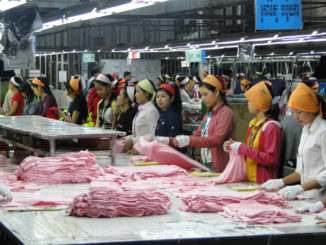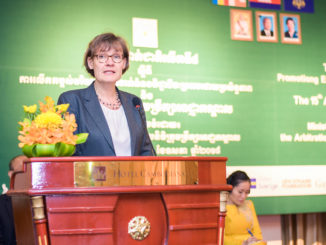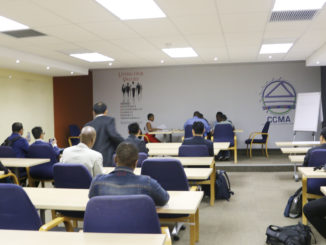
Significant Case 187/16 – First Gawon Apparel (Cambodia) Co Ltd.
Date of Award Issuance: 31 August 2016
Arbitral Panel: Pen Bunchhea, Seng Vouch Hun and Tuon Siphann
In this case the local union Coalition of Cambodia Apparel Worker Democratic Union (CCAWDU) (the “Claimants”) brought a claim against First Gawon Apparel (Cambodia) Co. Ltd. (the “Employer”). The Employer’s enterprise is located in Phnom Penh and core business is garment and textile manufacturing. At the time of this case being heard approximately 470 workers were employed.
This case involved seven demands; two of which were withdrawn by the Claimants and the remaining five issues were arbitrated by the Arbitration Panel (AP). Only one demand relating to the inclusion of annual leave payments in the calculation of the 90 days paid maternity leave will be examined in this case note.
Both parties agreed that the Employer used four and a half days of annual leave divided by two when calculating the 90 days of maternity leave for workers. By doing this, the Employer deducted four and a half days of annual leave by providing wages equal to 2.25 days (four and a half days of annual leave divided by two) to be included in the maternity leave calculations.
The Claimants argued that maternity leave payments have no relationship to annual leave entitlements thus the Employer cannot include annual leave payments into the maternity payment calculations.
The Arbitration Council (AC) examined Article 166, 167, 182 and 183 of the Labour Law (LL) and previous AC decisions.
Article 166 of the LL states: “…all workers are entitled to paid annual leave to be given by the employer at the rate of one and a half work days of paid leave per month of continuous service.”
Article 167, paragraph 2 of the LL states, “If the contract is terminated or expires before the worker has acquired the right to use his paid-leave, an indemnity calculated on the basis of Article 166 above is granted to the worker.”
Paragraph 3 of the same article states: “Apart from this, any collective agreement providing compensation in lieu of paid leave, as well as any agreement renouncing or waiving the right to paid annual leave, shall be null and void.”
In previous AC decisions, the AC considered that the right to annual leave can be exchanged for a cash payment only when the contract is terminated. (See previous Arbitral Award No. 51/04-Sam Han, issue 5; No. 08/07-Siu Quinh, issue 1; 17/12 – Peace Glory, issue 2 and 029/15-British American Tobacco Cambodia, issue 7)
Furthermore, the AC has decided that LL prohibits payment in lieu of annual leave during the period that workers are working for the Company. (See previous Arbitral Award No. 73/13-Yak Jin, issue 8 and 029/15-British American Tobacco Cambodia, issue 7)
In this case, the AC considered that the intention of the LL is to encourage workers to use annual leave but not payment in lieu if the employment relationship has not ended.
Article 182 of LL states: “…women shall be entitled to a maternity leave of ninety days…”
Article 183, paragraph 1 of LL states: “During the maternity leave as stipulated in the preceding article, women are entitled to half of their wage, including their perquisites, paid by the employer.”
Based on Article 182 and 183 of the LL the AC considered that during maternity leave workers are still employed by the Employer. Therefore, the practice of the Company to use four and a half days of annual leave payment divided by two to be included in the maternity leave payment is not in the spirit of the LL. Annual leave entitlements cannot be exchanged for cash during the employment contract including during periods of maternity leave.
Meanwhile, Clause 34 (D) of Prakas No. 099 states that the AC, “… has the power and authority to provide any civil remedy or relief which it deems just and fair, including Orders to cease immediately any other illegal or prohibited conduct, including but not limited to retaliation.”
In its decision, the AC ordered the Employer to cease the above practice and ordered the Employer to reimburse four and a half days of annual leave entitlements to workers which was deducted from their leave balance when they were on maternity leave. Further, workers were ordered to return 2.25 days of annual leave payments to the Employer.
This case highlights the importance of misuse of annual leave payments for maternity leave calculations. The LL encourages workers to use annual leave but prohibits payments in lieu and it can only be paid in cash when the employment is terminated by either party. During maternity leave the employment is not terminated therefore workers should be entitled to full annual leave entitlements even when they are not physically at work.



